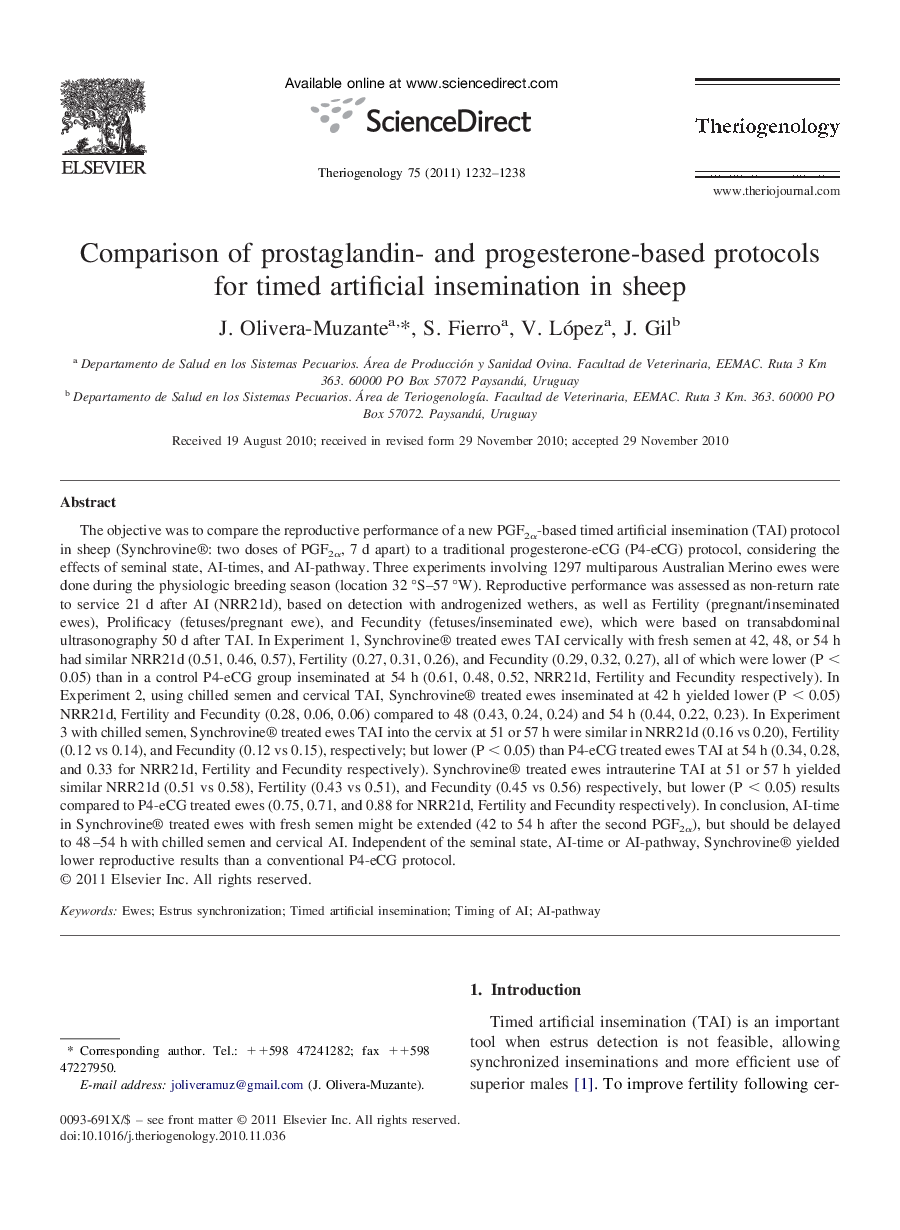| Article ID | Journal | Published Year | Pages | File Type |
|---|---|---|---|---|
| 10892804 | Theriogenology | 2011 | 7 Pages |
Abstract
The objective was to compare the reproductive performance of a new PGF2α-based timed artificial insemination (TAI) protocol in sheep (Synchrovine®: two doses of PGF2α, 7 d apart) to a traditional progesterone-eCG (P4-eCG) protocol, considering the effects of seminal state, AI-times, and AI-pathway. Three experiments involving 1297 multiparous Australian Merino ewes were done during the physiologic breeding season (location 32 °S-57 °W). Reproductive performance was assessed as non-return rate to service 21 d after AI (NRR21d), based on detection with androgenized wethers, as well as Fertility (pregnant/inseminated ewes), Prolificacy (fetuses/pregnant ewe), and Fecundity (fetuses/inseminated ewe), which were based on transabdominal ultrasonography 50 d after TAI. In Experiment 1, Synchrovine® treated ewes TAI cervically with fresh semen at 42, 48, or 54 h had similar NRR21d (0.51, 0.46, 0.57), Fertility (0.27, 0.31, 0.26), and Fecundity (0.29, 0.32, 0.27), all of which were lower (P < 0.05) than in a control P4-eCG group inseminated at 54 h (0.61, 0.48, 0.52, NRR21d, Fertility and Fecundity respectively). In Experiment 2, using chilled semen and cervical TAI, Synchrovine® treated ewes inseminated at 42 h yielded lower (P < 0.05) NRR21d, Fertility and Fecundity (0.28, 0.06, 0.06) compared to 48 (0.43, 0.24, 0.24) and 54 h (0.44, 0.22, 0.23). In Experiment 3 with chilled semen, Synchrovine® treated ewes TAI into the cervix at 51 or 57 h were similar in NRR21d (0.16 vs 0.20), Fertility (0.12 vs 0.14), and Fecundity (0.12 vs 0.15), respectively; but lower (P < 0.05) than P4-eCG treated ewes TAI at 54 h (0.34, 0.28, and 0.33 for NRR21d, Fertility and Fecundity respectively). Synchrovine® treated ewes intrauterine TAI at 51 or 57 h yielded similar NRR21d (0.51 vs 0.58), Fertility (0.43 vs 0.51), and Fecundity (0.45 vs 0.56) respectively, but lower (P < 0.05) results compared to P4-eCG treated ewes (0.75, 0.71, and 0.88 for NRR21d, Fertility and Fecundity respectively). In conclusion, AI-time in Synchrovine® treated ewes with fresh semen might be extended (42 to 54 h after the second PGF2α), but should be delayed to 48-54 h with chilled semen and cervical AI. Independent of the seminal state, AI-time or AI-pathway, Synchrovine® yielded lower reproductive results than a conventional P4-eCG protocol.
Related Topics
Life Sciences
Agricultural and Biological Sciences
Animal Science and Zoology
Authors
J. Olivera-Muzante, S. Fierro, V. López, J. Gil,
